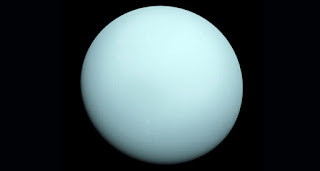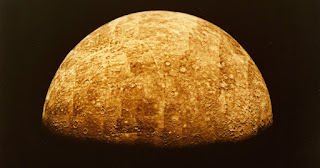Uranus
Uranus (pronounced YOOR un nus), the “icy giant,” is an odd planet. It is the seventh planet from the Sun and the only one in our Solar System that is tilted on its side for reasons scientists have not figured out. Its north and south poles lie where most planets have their equators. Its rotation axis tilt is oriented 97.77 degrees relative to its orbit, whirling around in a clockwise direction. Was it hit by another planet that caused a titanic collision? A new hypothesis was that Uranus had a ring system large enough to cause it to wobble on its axis like a spinning top. The rings are only about 600 million years old.
Its name, Uranus, is a reference to the Greek god of the sky, Ouranos. Astronomer Johann Bode suggested that it be name after the Greek god of the sky, Uranus. All the other planets are named after Roman gods except Uranus.
Uranus is the third largest planet, behind Jupiter and Saturn. It is the fourth-largest planetary mass in the Solar System.
Uranus had been observed by the naked eye in the past, but was mistaken for a star because of its dimness and slow orbit.
In 1690, English astronomer John Flamsteed (1646-1719) observed Uranus at least 6 times and categorized it as a star called 34 Tauri.
Uranus was the first planet found with the aid of a telescope in 1781. It was originally thought to be a comet or star. It took two years to decide that it was a new planet. This discoverer, Sir William Herschel (1738-1822), wanted to name it Georgium Sidus (George’s Star), after King George III. Herschel first observed Uranus by his seven foot reflector telescope on March 13, 1781. He initially reported his discovery on April 26, 1781 and thought it was a comet.
By 1783, Herschel acknowledged that what he observed was a planet as other astronomers computer a nearly circular orbit of the object, ruling out a comet. Herschel later discovered 6 moons orbiting Uranus.
In 1783, Pierre-Simon Laplace (1749-1827) first calculated its orbital elements.
In 1784, German astronomer Johann Elert Bode (1747-1826) determined the orbit of Uranus and suggest the planet’s name – Uranus. Other astronomers wanted to call it Neptune, before the planet now known as Neptune was discovered. [source: The Pennsylvania Packet (Philadelphia), Nov 3, 1790]
In 1841, John Couch Adams (1819-1892) observed discrepancies between the predicted orbit and the observed orbit of Uranus. He proposed that the differences were due to the gravitational tug of an unseen planet.
On September 23, 1846, Johann Gottfried Galle (1812-1910) discovered a new planet, later named Neptune, based on calculations by Urban Le Verrier (1811-1877). Verrier made his mathematical calculations to explain the discrepencies with Uranus’s orbit.
It wasn’t until 1850 before the name “Uranus” was accepted as the name of the planet.
Uranus has a ring system (13 distinct rings), a magnetosphere, and 27 known moons. The largest of the moons, Titania, has a radius of only 490 miles, or less than half that of the Moon.
Uranus orbits the Sun once every 83.75 years. Its average distance from the sun is 2 billion miles, or about 20 times the distance from the Sun compared to Earth (20 Astronomical Units, or 20 AU). Uranus ranges between a perihelion of 18.3 AU and an aphelion of 20.1 AU, the biggest range of any planet.
The rotational period of the interior of Uranus is 17 hours, 14 minutes. The upper atmosphere makes a full rotation in 14 hours.
Because of its tilt, the south pole of Uranus gets around 42 years of continuous sunlight, followed by 42 years of darkness. Nevertheless, Uranus is hotter at its equator than at its poles.
The mean apparent magnitude of Uranus is 5.66. The range of brightness is near the limit of naked eye visibility.
The mass of Uranus is 14.535 times that of Earth, making it the least massive of the giant planets. Its diameter is about 4 times that of Earth. Its density is 1.27 grams per cubic centimeter, making Uranus the second least dense planet, after Saturn. The gravity on Uranus is 0889 of Earth’s gravity.
The core of Uranus is about earth-size, made of iron and magnesium silicate. Its liquid mantle surrounding the core has a temperature of 9,000 degrees Fahrenheit.
In 1977, 6 rings of Uranus were discovered about NASA’s Kuiper Airborne Observatory who were watching a star pass behind Uranus.
In 1986, images from Voyager 2 (launched in 1977) showed Uranus as an almost featureless planet in visible light. Voyager 2 is the only spacecraft to visit the planet. On January 24, 1986, Voyager 2 came within 50,679 miles of the cloud tops, before continuing its journey to Neptune. Voyager 2 discovered 10 new moons during its flyby. The Goldstone Deep Space Communications Complex near Barstoe, California, monitored the Voyager 2 spacecraft’s approach to Uranus.
In 1998, the Hubble Space Telescope observed as many as 20 bright clouds at various altitudes in the atmosphere of Uranus. The bright clouds are probably made of crystals of methane, which condense as warm bubbles of gas from deep in the atmosphere of Uranus.
The planet smells like rotten eggs. In April 2017, astronomers found hydrogen sulfide in its clouds. The atmosphere is 83% hydrogen, 15% helium, and 2% methane.
Uranus radiates hardly any excess heat at all. Uranus has the coldest planetary atmosphere at -371 Fahrenheit (-224 Celsius. -375.5 Fahrenheit, or 49 Kelvin). The wind speeds of the clouds can reach up to 560 miles per hour. [source: Starr, “There’s a New Hypothesis For How Uranus Ended Up Tipped on its Side,” Science Alert, Mar 13, 2020]
In 2021, researchers reported the
discovery of X-rays being emitted fro Uranus.
The X-rays were detected using the NASA Chandra X-ray Observatory. Snapshots of the planet were taken in 2002
and 2017 from the spacecraft.
Researchers noticed a clear detection of X-rays in the first observation
and a possible flare in the second observation,





Comments
Post a Comment